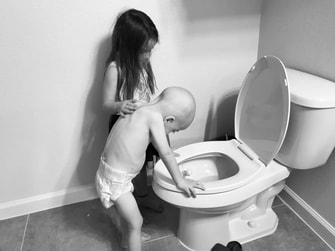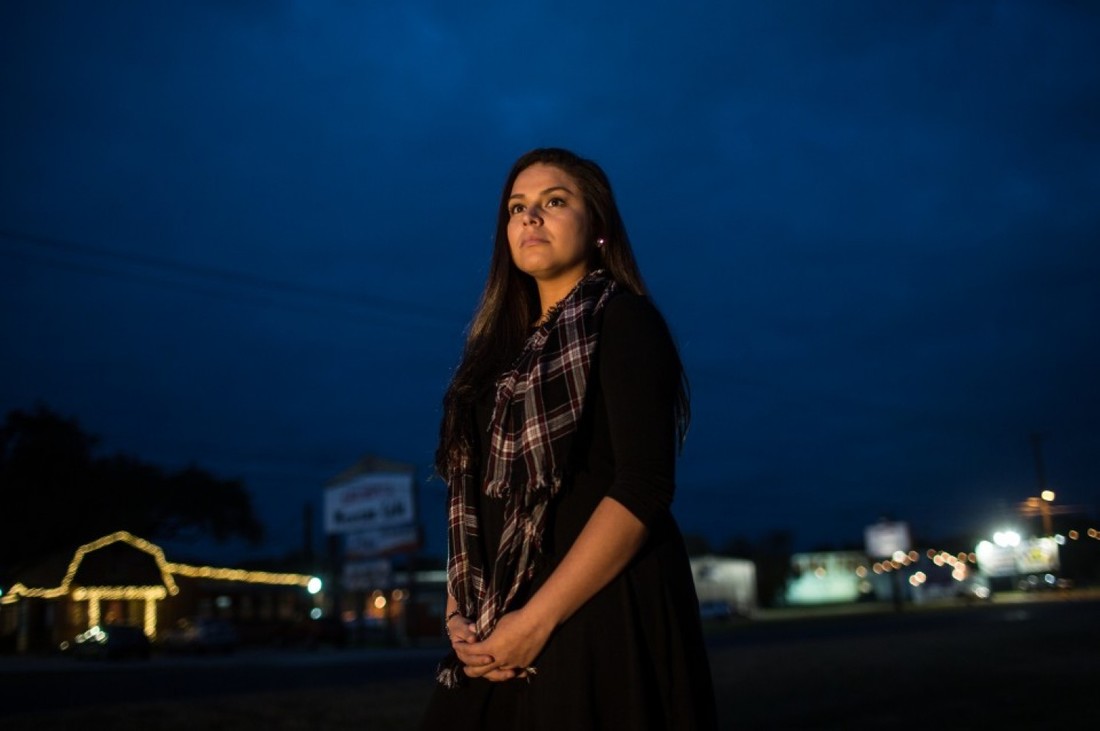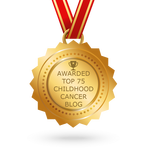 (CNN)Childhood cancer is draining, frightening and painful. A mother in Texas shared an unfiltered peek into how the disease impacted her family. Kaitlin Burge posted stirring photos of her 4-year-old son, Beckett, leaning over a toilet, with his 5-year-old sister, Aubrey, standing guard. Beckett was diagnosed with acute lymphoblastic leukemia over a year ago. "Vomiting between play sessions. Waking up to throw up. Standing by her brother's side and rubbing his back while he gets sick," she wrote. "This is childhood cancer. Take it or leave it." Burge said she took the photos in January, but they depict a "typical day in the life" for her son. Beckett takes a chemotherapy pill every night in addition to monthly trips to a clinic where he receives chemo through a port, and with chemo comes nausea. Her children make sacrifices for their brother. The photos, she said, show the reality of childhood cancer and its implications across families. "Our family's been split up," she said of sending her children to stay with their grandmother or her brother while Beckett's in the hospital. "We're all tired. Your relationships are tried. You lose a lot of friends. You don't get to go out and live the life you've been living prior to this." And focusing on Beckett's health has meant she has less time to devote to Aubrey and her 23-month-old daughter. "The siblings are forgotten about a lot of the time. They make a lot of sacrifices that people don't realize," she said. Aubrey has stayed by his side in the hospital and at home. At first, she didn't understand why her formerly playful younger brother slept all the time, couldn't walk on his own or got to skip school, Burge wrote. "She was so used to being the big sister," she told CNN. "Her world flipped." Families have embraced her message. Beckett should complete treatment in August 2021 after more than three years. It feels like an eternity for her family, Burge said. The process has grown increasingly costly, so a friend made a GoFundMe for Beckett's medical expenses. When Beckett was diagnosed, she felt like she was alone. But parents of children with cancer have embraced her post, revealed the community she didn't always know was there, she said. "Finding positive, I think, in the ugly, is a good outlook on life." One thing they don’t tell you about childhood cancer is that it affects the entire family. You always hear about the financial and medical struggles, but how often do you hear about the struggles families with other children face? To some, this may be hard to see and read. My two kids, 15 months apart, went from playing in school and at home together to sitting in a cold hospital room together. My then 4 year-year-old watched her brother go from an ambulance to the ICU. She watched a dozen doctors throw a mask over his face, poke and prod him with needles, pump a dozen medications through his body, all while he laid there helplessly. She wasn’t sure what was happening. All she knew was that something was wrong with her brother, her best friend. A little over a month after he was released from the hospital, she watched him struggle to walk and struggle to play. The lively, energetic, and outgoing little brother she once knew was now a quiet, sick, and very sleepy little boy. He never wanted to play. She didn’t understand how he was able to walk before this, but now he can’t even stand unassisted. She didn’t understand the different therapies he had to attend to gain his strength back. To her, it was something special he got to do that she didn’t. Why couldn’t they go to their favorite trampoline park anymore? Why couldn’t they go to the splash pads they previously went to? Why didn’t he have to go back to school, but she did? Why did we take his sister with us and why did she see all of this at a young age? Children need support and togetherness, and should not be kept at a distance from the person who is ill. The most important thing is to show that they are taken care of regardless of the situation. She spent a fair amount of time, by his side in the bathroom, while he got sick. She stuck by him. She supported him and she took care of him, regardless of the situation. To this day, they are closer. She always takes care of him. Vomiting between play sessions. Waking up to throw up. Standing by her brothers side and rubbing his back while he gets sick. Going from 30 lbs to 20 lbs. This is childhood cancer. Take it or leave it. 🎗
0 Comments
San Antonio resident Brittany Galan was diagnosed with leukemia when she was 6 weeks old. She underwent chemotherapy for two years and has had several health problems as a result of the treatment. (Tamir Kalifa for The Washington Post)
The rate of second malignancies in survivors of childhood cancer is declining — an improvement linked to reduced radiation treatment of the first disease, according to a new study. The research, published Tuesday in the Journal of the American Medical Association, focused on new cancers — not recurrences — that occurred within 15 years of the original ones. The rate for such cancers fell from 2.1 percent for survivors diagnosed in the 1970s to 1.3 percent for those diagnosed in the 1990s. For the same period, the percentage of pediatric cancer patients treated with radiation therapy fell from 77 percent to 33 percent, and the doses were ratcheted back. The study was the latest to suggest that efforts to modify potentially toxic cancer treatments — including radiation and chemotherapy — are paying off in reduced “late effects.” These are serious and sometimes life-threatening complications, such as second cancers, heart problems and infertility, that can affect cancer survivors years later. The research was based on data from the National Cancer Institute-sponsored Childhood Cancer Survivor Study, which tracks more than 30,000 survivors. The new analysis included more than 23,000 people treated over three decades. Oncologists and researchers had long assumed that reducing radiation would benefit pediatric cancer survivors, said Gregory Armstrong, an oncologist at St. Jude’s Children’s Research Hospital in Memphis and the principal investigator of the CCSS. But the new paper demonstrates the link, said Armstrong, one of the authors of the study. “We reduced radiation therapy and that reduced the risk,” he said. Even so, childhood cancer survivors remain at risk for later malignancies. Survivors from the 1990s are four times as likely to be diagnosed with another cancer than their peers who were never sick with cancer. Those treated in the 1970s are six times as likely to develop another cancer. The most common second malignancies are breast and thyroid cancers. |
AuthorBerni & Murcer, Friends for LifeTM Archives
September 2019
Categories |

 RSS Feed
RSS Feed
